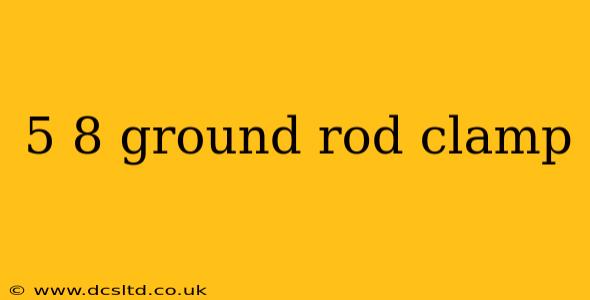5/8" Ground Rod Clamps: A Comprehensive Guide
Grounding is crucial for electrical safety, and a properly installed ground rod clamp is a vital component of any grounding system. This guide delves into the specifics of 5/8" ground rod clamps, addressing common questions and providing essential information for both professionals and DIY enthusiasts. We'll explore different types, applications, and installation best practices to ensure you're equipped to handle your grounding needs effectively.
What is a 5/8" Ground Rod Clamp Used For?
A 5/8" ground rod clamp is a connector designed to securely fasten a grounding conductor (typically copper wire) to a 5/8" diameter ground rod. This creates a low-impedance path to the earth, diverting fault currents and protecting against electrical shocks and equipment damage. Its primary use is in grounding systems for buildings, electrical panels, and other critical electrical installations.
What are the Different Types of 5/8" Ground Rod Clamps?
Several types of 5/8" ground rod clamps exist, each with varying features and suitability for specific applications:
-
Compression Clamps: These clamps use a screw mechanism to tightly compress the grounding wire and the ground rod, creating a secure connection. They are generally robust and reliable, suitable for a wide range of grounding applications.
-
Exothermic Welded Clamps: These clamps utilize an exothermic welding process to create a permanent, highly conductive bond between the ground rod and the grounding wire. This results in an exceptionally low-resistance connection, ideal for high-current applications or situations demanding maximum reliability. However, this method requires specialized equipment and expertise.
-
Bolt-On Clamps: These clamps use a bolt to secure the grounding wire to the ground rod. While simpler to install, they might require more frequent inspection to ensure the connection remains secure and corrosion-free.
How Do I Install a 5/8" Ground Rod Clamp?
Proper installation is crucial for effective grounding. Here's a general guide:
-
Preparation: Ensure the ground rod is driven deep enough to achieve the required grounding resistance. Clean both the ground rod and the grounding wire thoroughly to remove any dirt, paint, or corrosion.
-
Clamp Placement: Position the clamp securely on the ground rod. Ensure that the clamp jaws properly engage the ground rod and that the grounding wire is correctly positioned within the clamp's terminals.
-
Tightening: For compression clamps, tighten the screw firmly, ensuring a solid connection. For bolt-on clamps, tighten the bolt securely, following the manufacturer's specifications. For exothermic welds, follow the manufacturer’s instructions precisely, ensuring proper safety precautions are taken.
-
Inspection: After installation, inspect the connection for any looseness or signs of corrosion.
What is the Best Material for a 5/8" Ground Rod Clamp?
Most 5/8" ground rod clamps are constructed from copper-plated steel or high-quality copper alloys. Copper offers superior conductivity and corrosion resistance, making it the preferred material for long-lasting and reliable grounding. The use of plated steel offers a cost-effective alternative, but its longevity might be compromised if corrosion protection is not properly maintained.
How Often Should I Inspect My 5/8" Ground Rod Clamp?
Regular inspection is crucial to maintain the integrity of your grounding system. It's recommended to visually inspect ground rod clamps at least annually, checking for corrosion, looseness, or any signs of damage. More frequent inspections might be necessary in harsh environmental conditions or high-current applications.
What Happens if My 5/8" Ground Rod Clamp Fails?
A failed ground rod clamp can have serious consequences, including:
-
Electrical Shock Hazards: Loss of effective grounding increases the risk of electric shock to people and animals.
-
Equipment Damage: Fault currents might not be properly diverted, leading to damage or destruction of electrical equipment.
-
Fire Hazards: A poor ground connection can increase the risk of electrical fires.
Maintaining a reliable grounding system is non-negotiable for electrical safety. Regular inspection and proper installation of your 5/8" ground rod clamp are essential steps in mitigating potential risks. If you're unsure about any aspect of ground rod installation or maintenance, consult a qualified electrician.
